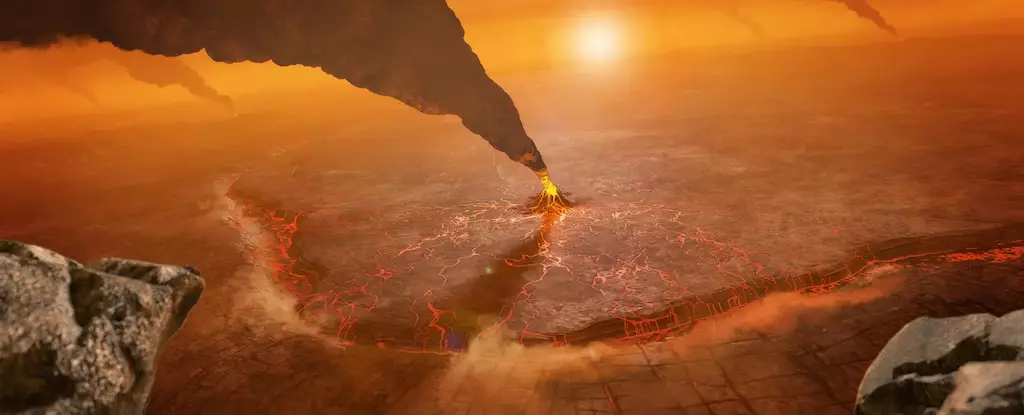Recent research has fundamentally reshaped our understanding of Venus, revealing that this harsh, hellish world may not be as alien as previously thought. While its high temperatures, sulfuric acid clouds, and crushing atmospheric pressure paint a picture of a planet that is unwelcoming to life, new insights suggest that Venus might host geological processes reminiscent of those that shape our own Earth. This comes from a pioneering study that revisits decades-old data, positioning the dense atmosphere of Venus as a veil hiding active tectonic-like mechanisms at work beneath its surface.
This reinvigorated analysis points towards a profound realization: the large, circular structures found across Venusian landscapes, known as coronae, could serve as crucial markers for understanding the planet’s inner workings. Unlike Earth, where tectonic activity is a dynamic and visible aspect of geography, Venus appears to operate on a different set of geological rules despite also exhibiting signs of internal activity. As planetary scientist Gael Cascioli from the University of Maryland and NASA’s Goddard Space Flight Center points out, the insights generated from combining gravity and topography data are transforming our comprehension of the planetary processes at play.
The Mystery of Coronae
The coronae on Venus initially intrigued scientists who mistakenly labeled them as impact craters. Upon closer investigation, it was revealed that these features are volcanic in origin. Each corona resembles a raised ring with a sunken interior, radiating concentric cracks like the rays of the sun. Spanning hundreds of kilometers, these structures hint at fundamental geothermal activity beneath the planet’s crust. Specifically, they are likely the result of hot mantle plumes pushing material to the surface, causing domes to rise and subsequently collapse once the magma cools.
A critical finding of this study is that the coronae may not stand alone; rather, they may be the manifestation of a broader tectonic system. While Venus lacks tectonic plates like those on Earth that allow for subduction and active geological features, the interactions between mantle plumes and the lithosphere could be generating similar phenomena. This finding paves the way for correlations between processes on Venus and those on our own home planet, revealing a deeper connection in the dynamics of terrestrial bodies.
Unraveling Venusian Geodynamics
Research into the processes underpinning coronae involved developing models to describe their formation linked to mantle plumes. By analyzing gravity and topographical data collected by NASA’s Magellan probe—an impressive piece of technology that orbited Venus in the 1990s—the research team identified 75 coronae, revealing intriguing truths about the planet’s geology. Notably, 52 of these structures cap hot, buoyant plumes of molten rock, suggesting that internal geodynamic processes are indeed at work.
What’s equally fascinating is how these processes mirror dynamics on Earth. In our own geological landscape, subduction occurs when one tectonic plate descends beneath another. While that’s not the case on Venus, a similar interaction might occur when surface materials are forced outward by rising mantle material. This spreading eventually leads to the destabilization and downward migration of some crust into the mantle.
Additionally, the phenomenon of lithospheric dripping observed here is proposed to occur on Venus, where intense heat causes portions of the lithosphere to melt and detach. These denser drips fall into the planet’s interior, contributing to the ongoing transformation of Venus’s surface. Though daunting, it showcases Venus as an environment alive with geological activity, contradicting earlier assumptions that deemed it largely inactive.
Addressing the Unknowns of Venus Exploration
Despite these promising insights, there remain considerable barriers to exploring Venus further. The extreme conditions of the planet make it a formidable challenge for any scientific inquiry. The energetic geological forces at play and the overall high-pressure environment hinder persistent exploration, making it critical to prioritize the study of coronae for future missions.
Further investigation into these features could provide critical insights into not only Venus’s history and evolution but may also yield parallels to Earth’s own geological processes—not just in understanding planetary science, but in grasping the geological history that binds our two worlds.
The findings shared by this research team underline a pivotal moment in planetary geology. As Anna Gülcher, a planetary scientist from the University of Bern notes, the abundance and significance of coronae suggest a highly active geological history that may parallel Earth’s formative years. These exciting discoveries compel us to re-examine not only Venus but our collective understanding of planet formation and the dynamic forces that shape planetary surfaces throughout the cosmos.


Leave a Reply